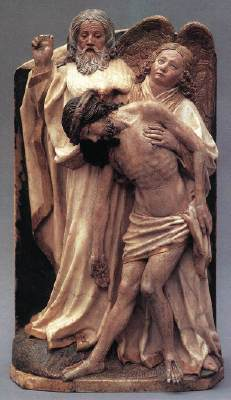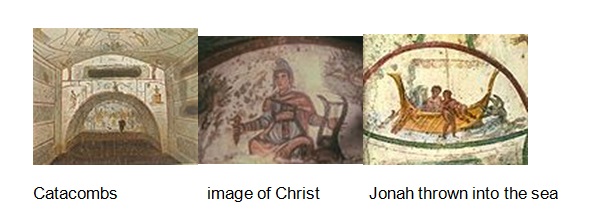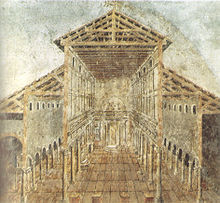Introduction
Byzantine art refers to the art that originated from Byzantine Empire. This empire resulted from the division that occurred in the Roman Empire, splitting the empire into two halves; the Eastern and the Western empire. This splitting also affected Italy since some parts of Italy fell under Byzantine rule. During this period, also referred to as Byzantine iconoclasm (730-843), many notable activities happened. Among such activities was the destruction of many sacred images. Due to this destruction, only a few of these sacred icons exist and are mostly found in Italy, Egypt, or Mount Sinai. However, these images have now been spread to many other parts of the world. These images are used by Christians to have various cultural, religious and conservative meanings. The purpose of this paper is to focus on Early Christian and Byzantine art, artifacts, and architecture. This will be done by identifying specific pieces by establishing their titles, artists, date of creation, original location and the media.
History of byzantine art
The byzantine art served many purposes including religious, cultural and conservative purposes although they still retained the Greek originality. Icon production returned in 1473 and by that time the byzantine art tradition adopted many changes which were attributed to the fall of the Empire. Runciman, (47) supports this saying, “there was a notable revival of the classical style in works of 10th-century court art like the Paris Psalter, and throughout the period manuscript illumination shows parallel styles, often used by the same artist, for iconic figures in framed miniatures and more informal small scenes or figures added unframed in the margins of the text in a much more realist style”. The changes continued until byzantine art started to be influenced by western European art. These changes persisted until the end of the Byzantine Empire whereby byzantine art provide models of European rulers. Cormack (117) provides an example of such changes saying, “for example Byzantine silk textiles, often woven or embroidered with designs of both animal and human figures, the former often reflecting traditions originating much further east, were unexcelled in the Christian world until almost the end of the Empire”.
However, byzantine heritage was not completely lost to western culture after the collapse of the Byzantine Empire. This heritage continued to be a source of inspiration to Christians. During this time, Christians modified the classic idiom so as to express the continued faith for the Orthodox faith. According to Lowdon (23), “early Christian art of the 3rd and 4th centuries had simply taken over the style and forms of classical paganism”. The free-standing statue was the most common art and it stressed the possibility of the physical presence of a tangible god. Due to the influence of Christianity, artists were inspired to make spiritual characters that had sacred figures. Mosaicists and painters tried as much as they could to avoid modeling figures that would suggest a tangible human creature. By the end of the 5th century, the sculpture was restricted to the use of ivory plaques. The interior adornment of the Byzantine churches preferred the use of mosaic models. Cormack (56) notes that “the small cubes, or tesserae, that composed mosaics were made of colored glass or enamels or were overlaid with gold leaf”. The luminous effects of mosaic could be felt on the walls and were well adapted in a way that it could express the specific Orthodox Christianity character.
Pieces of byzantine arts
The majority of people in the Roman Empire rejected the belief of many gods (polytheism) during the fourth and the third century. The then Roman empire had influenced many people to believe in many gods (Kleiner, 32). This change in belief system resulted in the people believing in one God or the all-powerful God. Christianity dominated this region as the most prominent religion since it had many followers. This was a move that did not impress Emperor Diocletian. As a result, the emperor got annoyed with the increasing number of Christians including in the army and he, therefore, ordered more persecutions. There existed a conflict between the Romans and the Christians. The reason for this conflict was because the Romans hated the Christians for their belief in one God who existed as a human being and that the death and resurrection of Christ guaranteed life after death for them. Another major reason for the conflict was that the Christians refused to pay homage to the official god of the Romans. This conflict continued to persist until the emperor believed that the God of Christians had power and that this power protected the Christians against evils. The Christians who lived in those days, therefore, used some artworks that had Christian values and attributes (Kleiner, 21).
Christ Pantocrator mosaic
The “Christ Pantocrator mosaic” mosaic was created between 1080 and 1100. Originally located in Greece, it is one of the names that were used to refer to God. The meaning of this art to Christians was that God was almighty or powerful meaning that he had the power to do anything. The mosaic is made up of a semi-dome icon that looked the figure of Jesus, with his right hand raised as if he was blessing or teaching. The gessoed panel of the art was painted finely by the use of wax median placed on a wooden panel. However, some changes were introduced to this mosaic later. One such change was the cleaning of the wax that was over-painted on the faces and hands; this cleaning revealed that that the mosaic was a high-quality icon. The mosaic was originally intended to represent the figure of God the creator but was later transformed to represent Jesus. This transformation came as a result of the Christological shift in the fourth century. The new meaning of the mosaic was to refer to Jesus as a powerful judge of human life (Lowdon, 24).
Trinity life
The sculptor was developed in the early 15th century. The sculptor was made of a combination of some hard materials such as marble, metal, or glass and some soft ones like clay and polymers. The materials used were hardened through firing, joined through welding, and modified through carving (Runciman, 23). The sculptor was decorated by painting the surface. The sculptor represented dying Christ held by an angel preventing him from falling. The hands of Christ were crowned with thorns, his mouth and eyes were slightly open. The chest and hands of Christ had a network of veins that indicated that he was body did not appear as that of a normal human being. The sculptor enhanced this by coloring the skin with various tones while the wounds were painted with red color. However, the faces and hands of God and the angel were painted with a color indicating naturalistic coloring. According to Kleiner (45), this “relief is stylistically indebted to Late Gothic Netherlandish realism”. The sculptor represented the dying Christ which was interpreted by Christians as the sacrifice that Jesus. Kleiner (45) argued that “theologically, this shows the acceptance of the sacrifice through which the divine plan of salvation can be fulfilled”.

Lamentation by Giotto
The first painting of this byzantine art was created by an anonymous artist in 1164. This art was located in the city of Nerezi in Macedon. The other byzantine was developed by Giotto between 1304 and 1306 in Padua Italy. According to Lowdon (112), the art represented “the Virgin Mary embracing the deposed Christ, the curved body of the disciple holding the hand of Christ, within a very briefly indicated location and schematic spatial setting”. The art was designed using a two-dimensional concept of painting which made it differ from Hellenistic art. For instance, tonal and color modulation was employed. Giotto’s figure was solidly unified using the spatial setting.
Cubicula
Cubicula were small rooms that were meant to act as mortuary chapels in the catacombs. An example of such a cubiculum was the one that was designed at the Saints Peter and Marcellinus catacombs in Rome (Kleiner, 45). This cubiculum had a ceiling that was painted at the center and it had a big cross that symbolized the Christian faith. There are four semi-circular frames at the end of the arms which contained various episodes about the story of Jonah in the Old Testament. Runciman (123) describes that episode of Jonah as “on the left, the sailor threw him out of his ship, he emerges on the right from the whale that swallowed him, at the bottom, safe on land, and Jonah contemplates the miracle of his salvation and the mercy of God”.
An interpretation of this art was that; there was an important role that was played by the Old Testament. This was because Jesus was a Jew and therefore most of his followers were people who were converted to follow the Jewish customs. Therefore the Christian arts reflected how messages of the Old Testament played a prophetic role by predicting what would happen in the New Testament. An example of this message in the art was the use of Jonah to prophesy a certain message (Kleiner, 66). Jesus himself used this same story of Jonah in the New Testament when he said that Jonah spent three days in the belly of a sea monster and finally he was saved. By using this message, Jesus wanted to imply that he would die and resurrect on the third day. Therefore, cubicula were designed with a brown color that symbolized the agony that Jonah underwent in the process of completing the mission he was sent to do. Every step in the first three edges of the cross symbolized that Jonah really suffered in the course of his mission. However, the final edge of the cross had the picture of Jonah proclaiming the miracles and praising the works of God. The message that Christians got from this art was that; every follower of Christ would be subjected to suffering for a short period but will later be saved by God and be rewarded an everlasting life.

Jonah lunettes
Jonah’s lunette was used to design this byzantine art which was found in Rome. There was at least one child, a man and a woman in every compartment. In every compartment, there were praying figures (orants), with their arms raised in a traditional way of worship. The art was designed in a way that the praying figures raised their hands together and in a united manner. This was interpreted by Christians to mean that Christian families from different sections of life should worship together in order to seek the kingdom of God. Lowdon (143) describes early Christian art as “Christ often appears as the youthful and loyal protector of the Christian flock”. Christians used this phrase in the art to understand how they were supposed to worship together as a member of the same family.
Sarcophagus
This art was preferred by the Christians who were wealthy at that time. These Christians behaved like pagans. It was designed by Junius Bassus in the city of Rome (Kleiner, 46). The art was designed to have two registers, each having five compartments that were framed with columns. The frame was ten inches and was filled with stories of the old and New Testament. Jesus was designed to take a place in each register at the central compartment. Jesus was also enthroned as a teacher with two of his disciples Paul and Peter entering Jerusalem on a donkey. The upper zone of the art was designed to have Jesus sitting above the sky as a roman emperor holding a mantle. The sarcophagus was designed to convince Christians that Jesus was really the king of the universe. However, the two compartments on the upper right showed that Jesus was later arrested and led to Pontius Pilate for judgment. The Romans judged Jesus for blasphemy and condemned him to death and which he later rose.
Old Saint Peter church plan
The early Christians used private houses which were modeled in order to accommodate a small group of worshippers. The sponsorship that was introduced by Constantine led to the urgency for constructing churches. The emperor believed that it was the god of the Christians who provided him victory and therefore, there was a need to appreciate and protect the Christians within the empire.
The new buildings which were built to act as churches were required to meet the liturgy of Christianity.
The old saint peter was the largest church built during the Constantine era. It is this same site that the modern saint peter church in Rome is built. Peter was the first founder of this church and was buried beneath it (Kleiner, 56). Christians excavated the floor and built a monument in honor of the first Christian martyr. The old saint Peter was built in a different way from other temples in the empire. This was because Christians did not have their ways of worship to be considered similar to those of the pagans. Lowden (45) notes that “it had a wide central nave (300 feet long) with flanking aisles and apse at the end”. It also had a courtyard that preceded the central nave. The reason for this was; when the Christians got out of the nave, they would see the alter without any obstruction. According to Cormack (134), “unlike the Roman temples, Old Saint Peter’s did not have a sculptor-filled pediment to impress those approaching the church. Their early Christians interpreted this design by the architects as a way to break the similarity between their church and the pagan’s temples.

Conclusion
This paper has identified some of the byzantine arts that were used by the early Christians. According to the analysis of the design of the arts, it was identified that those arts had unique designs and were meant to deliver specific messages to Christians. Most of the arts were about the journey that Christians would undergo in their quest for the everlasting life promised to them by their leader Jesus. Therefore Jesus was used in most of the journeys to show the Christians what was expected of them.
Works Cited
Cormack, Robin. Painting the Soul; Icons, Death Masks and Shrouds, London: Reaktion Books, 1997.
Kleiner, Fred. Gardner’s Art: A Concise Western History. (Second Edition). New York: Cengage Learning Inc, 2009.
Lowdon, John. Early Christian & Byzantine. 2008. Web.
Runciman, Steven. Byzantine Style and Civilization. 2006. Web.